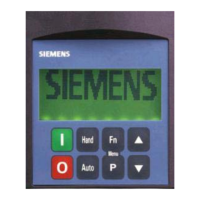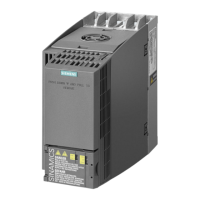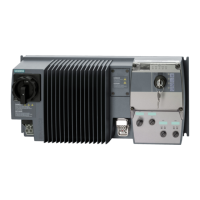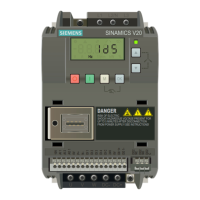63/80
Siemens Building Technologies Commissioning Guide CM1G5192en
HVAC Products 10 Parameterization 26.02.2003
Note:
It is possible to disable all reverse commands (i.e. the command is ignored). To do this, set P0719=0 (remote selection
of command / setpoint source) and define the command sources (P1113) individually.
This function does not disable the "reverse" command function; rather, a reverse command causes motor to run in the
normal direction as described above
P1120 Ramp-up time
Time taken for motor to accelerate from standstill up to maximum motor frequency (P1082)
when no rounding is used
Unit: s Min: 0.00 Def: 10.00 Max: 650.00
Level 1
Details:
Setting the ramp-up time too short can cause the VSD to trip (overcurrent)
If an external frequency setpoint with set ramp rates is used (e.g. from a PLC), the best way to achieve optimum VSD
performance is to set ramp times in P1120 and P1121 slightly shorter than those of the PLC
P1121 Ramp-down time Level 1
Time taken for motor to decelerate from maximum motor frequency (P1082) down to standstill
when no rounding is used
Unit: s Min: 0.00 Def: 30.00 Max: 650.00
Details:
Setting the ramp-down time too short can cause the VSD to trip (overcurrent (F0001) / overvoltage (F0002))
P1135 OFF3 ramp-down time
Defines ramp-down time from maximum frequency to standstill for OFF3 command
Unit: s Min: 0.00 Def: 5.00 Max: 650.00
Level 3
Note:
This time may be exceeded if the VDC_max. level is reached
P1140[2] BI: RFG enable
Defines command source of RFG enable command (RFG: ramp function generator)
Unit: - Min: 0.00 Def: 1.0 Max: 4000.0
Level 3
Index:
P1140[0]: VSD in Auto mode
P1140[1]: VSD in Hand mode
P1141[2] BI: RFG start
Defines command source of RFG start command (RFG: ramp function generator)
Unit: - Min: 0.00 Def: 1.0 Max: 4000.0
Level 3
Index:
. P1141[0]: VSD in Auto mode
P1141[1]: VSD in Hand mode
P1142[2] BI: RFG enable setpoint
Defines command source of RFG enable setpoint command (RFG: ramp function generator)
Unit: - Min: 0.00 Def: 1.0 Max: 4000.0
Level 3
Index:
. P1142[0]: VSD in Auto mode
P1142[1]: VSD in Hand mode
P1200 Flying start
Starts VSD onto a spinning motor by rapidly changing the output frequency of the VSD until the
actual motor speed has been found. Then, the motor runs up to setpoint using the normal ramp
time
Unit: - Min: 0 Def: 0 Max: 6
Level 3
Settings:
0 =Flying start disabled
1 =Flying start is always active, start in direction of setpoint
2 =Flying start is active if power on, fault, OFF2, start in direc-
tion of setpoint
3 =Flying start is active if fault, OFF2, start in direction of
setpoint
4 =Flying start is always active, only in direction of setpoint
5 =Flying start is active if power on, fault, OFF2, only in
direction of setpoint
6 =Flying start is active if fault, OFF2, only in direction of
setpoint
Note:
Useful for motors with high inertia loads
Settings 1 to 3 search in both directions
Settings 4 to 6 search only in direction of setpoint
Flying start must be used in cases where the motor may still be turning (e.g. after a short mains break) or can be driven
by the load. Otherwise, overcurrent trips will occur
P1202 Motor current: Flying start
Defines search current used for flying start
Unit: % Min: 10 Def: 100 Max: 200
Level 3
Details:
Value is in [%] based on rated motor current (P0305)
Note:
Reducing the search current may improve performance for flying start if the inertia of the system is not very high
P1203 Search rate: Flying start
Sets factor by which the output frequency changes during flying start to synchronize with turning
motor. This value is entered in [%] relative to the default time factor defines the initial gradient in
the curve below (and thus influences the time taken to search for the motor frequency):
fmax + 2 f slip
Unit: % Min: 10 Def: 100 Max: 200
Level 3
Details:
Enter this value in [%] relative to default time factor (which defines the initial gradient and influences time taken to search for
motor frequency). The search time is the time taken to search through all possible frequencies (between [f_max+2*f_slip]
and 0 Hz)
P1203=100 % is defined as giving a rate of 2 % of f_slip,nom / [ms]
P1203=200 % would result in a rate of frequency change of 1 % of f_slip,nom / [ms]
Example:
For a motor with 50 Hz, 1350 rpm, 100 % would produce a maximum search time of 600 ms. If the motor is turning, the
motor frequency is found in a shorter time
Note:
A higher value produces a flatter gradient and thus a longer search time
A lower value has the opposite effect

